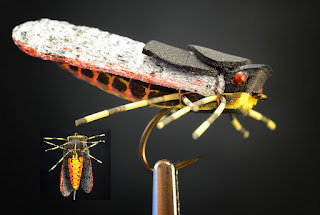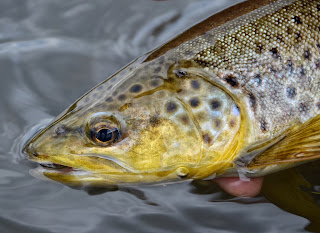Why skimp on your most important piece of gear?
 |
| Copper John tied on a TMC 2499SPBL |
The hook. The essence of a fly, and the business end of what makes our sport what it is. When I first started tying flies, there was a wide array of hooks that could be bought at the fly shop, online, or in my case in Dennis Brakke's garage. When I first started out, I bought the original Mustad hooks that were so popular because they were cheap, readily available, and strong. These hooks were very functional, but they were lacking what I later found to be the most critical part of a hook... A sharp point. Sharp hooks are critical to fly fishing because of the minimal pressure applied to the fish (compared to most other styles of fishing) when setting the hook. Sharper hook points will protect your tippet, penetrate more easily, and essentially catch you more fish. I remember my first pack of Tiemco hooks, scratching the hook across my thumbnail only to have it dig in - THIS was a real - live - hook. I learned that the key to these lazer sharp hooks was a chemical process that the manufacturers used to sharpen them. Chemically sharpened, conical point hooks became the only hooks I tied with.
The aforementioned Mr. Brakke, who is no longer with us, taught me a lot about hooks in my early years of tying, and inspired my tying a lot. He was always tinkering with different varieties of hooks, and showed me what to look for is a quality hook.
In todays market, there are many manufacturers that make fine quality hooks, and I have tied and fished with most of them. Chemically sharpened hooks are more readily found, and even Mustad has moved to chemically sharpened hooks. Mustad's signature series is a very fine quality hook with a needle sharp point that far surpasses the Mustads of years past. For you streamer aficionados and people who like to tie and fish BIG stuff; there is a hook for you. Eagle Claw (a company that proudly makes hooks in the USA) has come out with a line of hooks tailored mostly to bass fishermen called Lazer Trokar. They use lazer technology to cut the points on their hooks into a three sided killing machine. I have been bass fishing with them for a few years now, and they are probably the meanest hooks for big bugs on the market. If a fish even looks at it wrong, you are going to hook up. They are a bit spendy, but if you are chasing a trophy, it would be worth it to tie your trophy flies on a Trokar.
As you will see, there isn't much that I don't like, but I decided to break down several of my favorite hooks.
Tiemco / TMC
 |
| Bunny Midge on a TMC 518 #30 |
- 3761 - Slightly longer than a normal nymph hook and heavy wire. Great for longer nymphs such as the Masked Marauder, or other stonefly nymphs. I love the #10 and the #12.
- 102Y - Light wire dry fly hook with a wide gape. I don't know if I just love the matte black color of the hook, or the odd sizing. I use this hook a lot, and use them when I tie the Grumpy Frumpy, or Iris Caddis. I like the #13 and #17
- 2488 - This is perhaps one of the most versatile hooks made. A wide gape curved shank hook with a straight eye. I use them for everything from #28 midges, to #10 chironomids.
- 2499SPBL - Imagine the 2488 on steroids. It's barbless, but it has the spade point that penetrates very quickly. I like this in bigger sizes for Czech nymphs and stoneflies.
- 100 and 100SPBL - The Tiemco 100 is their standard dry fly hook. I use it for dries, nymphs, soft hackles, etc. It's just a great all around hook. The SPBL is barbless with the mean cutting point.
- 5262 - 2x long streamer hook. I tie most of my stillwater flies on this style of hook.
- 5212 - 2x long dry fly hook. This is a great hook style for hoppers and other long bodied dry flies. I also tie stimulators on this hook instead of the TMC 200R due to a wider hook gape. You can see that the 200R didn't make my favorite list but that's another story...
- 518 - This is a great hook for tying micro flies in the #28-32 range. Yes the fish eat them.
 |
| Stonefly on a Mustad C49S |
- C49S - Scud/pupa hook similar to the TMC 2488, but with a slightly different bend. This has become one of our favorite hooks, and Curtis even tied big hopper patterns with it.
- R30-94833 (Barbless Dry) - Very light wire barbless dry fly hook. I like it for fishing very delicate dry flies and light leaders.
- R72 (Streamer) - Another great 2x long streamer hook. the Cheech Leech on this one when they are sitting on my desk.
Allen Flyfishing
A lot of people have asked up about their hooks, and we have been very impressed with the quality, especially in their barbless series. I have purchased about 3500 of these hooks to date, and they have proven to be worth every penny. Here are some of my favorites.
A lot of people have asked up about their hooks, and we have been very impressed with the quality, especially in their barbless series. I have purchased about 3500 of these hooks to date, and they have proven to be worth every penny. Here are some of my favorites.
 |
| Elk Hair Caddis tied on an Allen D102BL |
- B200 - Bass bug hook. I tie most of my El Sculpitos on this hook, and it holds up great to being banged off of the rocks constantly.
- D102BL - This dry fly hook has amazing retaining ability for a barbless hook. I have started to switch to this hook for my dry fly needs. I only wish it came in sizes smaller than 16.
- D104 - 2xl dry fly hook. For a light wire hook it has great strength, and a really good point.
- J100BL - $3.49 for a legit competition ready barbless jig hook? Yes please.
- N204BL and N203BL - LIght and heavy wire scud hooks. Need I say more? This is the original hook that I ordered to see what kind of quality I was dealing with. They passed the test with flying
colors.![]()
Stonefly tied on an Allen J100BL - N205BL- Their newest release in the barbless arena. It's got a great bend that is great for Czech nymphs and caddis pupae. It is also light enough to tie emergers and dry flies.
- S402 and S402BL - This is the one that gets the most mileage on my desk. Great for stonefly nymphs, buggers and Cheech Leeches. The BL is crazy sharp.
- 1130 - One of my favorite curved shank hooks for dry flies. Thin wire, and slightly offset. This thing hooks up really well.
- 1150 and 1250 (barbless) - Another curved shank hook that has a slightly "up" eye. This hook makes great chironomids and pupae patterns.
- 1710 - 2xl nymph hook that is great for anything from stoneflies and mayflies in the smaller sizes, to wooly buggers in the larger sizes.
- 2461 (Black straight eye 3xl) - This. Hook. Is. Mean. One of my new favorites. Flat black finish, and SHARP!!!
Dai Riki
- 730 - 2x nymph hook. An affordable option for a bugger/nymph hook. Typically sold in quantities of 50. I have not had any problems with this hook. Gold finish.
- 135 Scud/Pupa - Dai Riki's scud hook. Again, a good product for the money.
Umpqua Comp series (Hanak)
- 300BL Scud/Pupa - Finally a good comp hook that is readily available. These are top of the line barbless hooks, and you will pay the price for them.
- 400BL Jig - Great hook for tying your anchor flies on. With a tungsten bead, this one will ride hook point up and slither over rocks.
Umpqua U series - B sides... ( I avoid these hooks in smaller sizes.)
- U301 3X nymph/streamer - I typically have these in sizes 2 and 4. That's about the only size that has a consistent barb. I have had deformities in barbs and eyes with these, but they are fairly cheap.
- U502 Bass bug hook - This seems to be one of the shining stars of the U series. Black nickel finish, and nice points/barbs.
Gamakatsu
- S10 - This is a 2x long 1x fine dry fly hook. I really like it for terrestrials and other longer bodied terrestrials.
- R10B - 1x fine dry fly hook that is barbless. This hook really penetrates well and retains fish due to its funky bend. It is a very light wire hook, and I have bent some on fish, but it is a great tool for light line fishing to picky fish.
- B10S - This hook has the same design as some of the wide gap bass bug hooks, and is great for warmwater flies, streamers, and some terrestrials. I always have these on hand from 2/0 to 6.
- C12U - This is THE worm hook. I tie a lot of pig sticker style worms on this hook and it really hooks up well.
- C12 BM 26-30 - This little hook is pretty insane... Gammy quality all the way down to #30. It also has somewhat of a larger eye to make threading tippet a bit easier.
Lazer Trokar
- TK180 Straight eye streamer hook. Designed to be fished with plastic worms, there is a plastic barb that is easily cut off to make it tying friendly. The hook points on these Trokars are INSANE!!
![]()
Cheech Leech tied on two TK180s - TK97 Curved shank / straight eye hook. This is a great hook for tying clouser type flies. This hook has pretty heavy wire, so a weightless fly will suspend and slowly sink. This is my preferred hook for the low fat minnow.
- TK10 Straight shank, straight eye, and straight money for pike/musky flies. It has a welded loop and very think wire designed to be fished for huge saltwater fish. I also use this a lot for bass patterns.
Cabela's
- Why rate Cabela's hooks? Because they are essentially identical to TMC hooks. A Cabela's employee once told me that they get their TMC orders and the Cabela's hook orders in the same package... The finish is dead on and the quality is great.
As a general guideline, if you stick to hooks that have a conical - chemically sharpened point, you will have better luck hooking and keeping fish. The above list is just a compilation of some of the hooks that I like to tie with. I hope you find some of this information helpful so you can go out and rip some big fish!
~Cheech




































